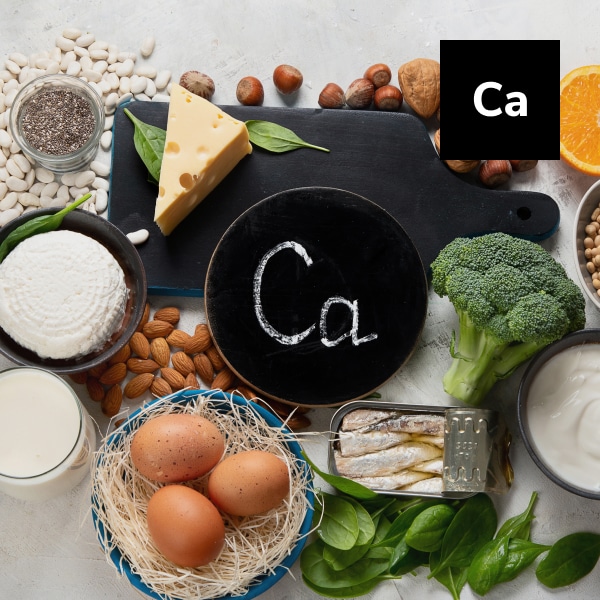Overview
Calcium is the most abundant mineral element in the body and the fifth most abundant mineral on the planet. It is obtained primarily from plants, dairy products, and seafood. Calcium is required for the maintenance of healthy bones and teeth, blood coagulation, nerve tissue and muscle function (including the heart), enzymatic functions, and the management of fluid transport through cell membranes. Additionally, it aids in the body’s iron utilization by regulating the levels of other minerals and fostering more efficient iron utilization.
Key Benefits
- Builds and maintains bones and teeth structure
- Helps regulate heart rhythm
- Promotes restful sleep
- Aids in the regulation of the influx and egress of nutrients across the cell membranes
- Assists in normal blood clotting
- Helps maintain proper nerve and muscle function
- Helps maintain normal blood pressure
- It is important for normal kidney function
- Prevents muscle cramping
- Reduces risk of preeclampsia in pregnancy
History of Usage
Calcium supplementation was used for medical purposes starting in the middle of the 19th century. Calcium chloride was used originally, but it tasted too salty and caused indigestion. Later came calcium carbonate, which is derived mostly from oyster and mussel shells, but it isn’t environmentally friendly. A synthetic carbonate similar to limestone and marble was used to make calcium in the early 1900s. It is on the World Health Organization’s List of Essential Medicines, and in 2017 it was the 262nd most commonly prescribed medication in the U.S.
Today, calcium supplements are found in the forms of calcium carbonate, calcium gluconate, calcium citrate, calcium citrate malate, calcium lactate, calcium amino acid chelates, microcrystalline hydroxyapatite (from a bone meal), and from plant sources, such as algae.
Biochemistry
The skeleton contains 99% of the body’s calcium. We need calcium to build and maintain strong bones, to assist in muscle and nerve function, blood clotting, cellular health, and the release of some hormones. Since we can’t produce it, we must get it through food and/or supplements.
The small intestine is the primary site for the absorption of dietary calcium. It is primarily deposited in bones as a result of circulation. Calcium discharged in the urine and feces is due to an excess or incomplete absorption. Calcitonin and parathyroid hormone (PTH) are the primary regulators of calcium homeostasis. When serum calcium level drops, PTH promotes calcium release from the bones and stimulates reabsorption of calcium by the kidney tubules. Calcium absorption is also increased by PTH through calcitriol, which is the hormonal version of vitamin D and is produced by the kidneys. When serum calcium levels rise, calcitonin suppresses calcium release from the bones and reduces calcium reabsorption by the kidney tubules.
Calcium is found in dairy products, dark, green leafy vegetables, fish with edible soft bones, and calcium-fortified foods and beverages. Calcium supplements should be used by those who are vegan, lactose-intolerant, consume a lot of protein or sodium, are on long-term corticosteroid medication, or suffer from digestive problems that reduce their ability to absorb calcium, with the advice of a health care practitioner. Vitamin D is also required for calcium absorption.
Calcium and vitamin D may have additional health benefits, according to new research. Adults over 51 should take 1,200 milligrams a day, while those under 19 should take 1,000 milligrams a day.
Recent Trends
According to official statistics, 61% of women in the United States over the age of 60 took calcium supplements in the years 2003–2006. This has resulted in a multi-billion dollar industry for calcium supplements, which are now consumed by millions of people, young and old, in order to maintain or improve their bone health.
Calcium supplements come in a range of different formats, including pills, capsules, chewable, liquids, and powders.
Precautions
- Too much calcium can result in the development of kidney stones.
- In rare cases, excess calcium can result in hypercalcemia, calcium deposits in the blood.
- Excessive amounts of calcium can result in constipation, gas, and bloating.
- Some research indicates that too much calcium might increase risk of cardiovascular disease.
References
- Nutrition and healthy eating. (2015, August 5)
mayoclinic.org/healthy-living/nutrition-and-healthy-eating/in-depth/calcium-supplements/art-20047097?pg=2 - Li K, Wang XF, Li DY, Chen YC, Zhao LJ, Liu XG, Guo YF, Shen J, Lin X, Deng J, Zhou R, Deng HW. The good, the bad, and the ugly of calcium supplementation: a review of calcium intake on human health. Clin Interv Aging. 2018 Nov 28;13:2443-2452. doi: 10.2147/CIA.S157523. PMID: 30568435; PMCID: PMC6276611.
- Tankeu AT, Ndip Agbor V, Noubiap JJ. Calcium supplementation and cardiovascular risk: A rising concern. J Clin Hypertens (Greenwich). 2017 Jun;19(6):640-646. doi: 10.1111/jch.13010. Epub 2017 May 2. PMID: 28466573.
- Gahche J, Bailey R, Burt V, Hughes J, Yetley E, Dwyer J, Picciano MF, McDowell M, Sempos C. Dietary supplement use among U.S. adults has increased since NHANES III (1988-1994). NCHS Data Brief. 2011 Apr;(61):1-8. PMID: 21592424.
- Institute of Medicine (US) Committee to Review Dietary Reference Intakes for Vitamin D and Calcium . In: Dietary Reference Intakes for Calcium and Vitamin D. Ross AC, Taylor CL, Yaktine AL, Del Valle HB, editors. Washington, DC: National Academies Press; 2011. [Accessed September 13, 2018]
- Brini M, Calì T, Ottolini D, Carafoli E. Intracellular calcium homeostasis and signaling. Met Ions Life Sci. 2013;12:119–168.
- Krebs J, Agellon LB, Michalak M. Ca(2+) homeostasis and endoplasmic reticulum (ER) stress: An integrated view of calcium signaling. Biochem Biophys Res Commun. 2015;460(1):114–121.
- Kleeman CR, Massry SG, Coburn JW. The clinical physiology of calcium homeostasis, parathyroid hormone, and calcitonin. I. Calif Med. 1971;114(3):16–43.
- Blaine J, Chonchol M, Levi M. Renal control of calcium, phosphate, and magnesium homeostasis. Clin J Am Soc Nephrol. 2015;10(7):1257–1272.
- Khaing W, Vallibhakara SA, Tantrakul V, Vallibhakara O, Rattanasiri S, McEvoy M, Attia J, Thakkinstian A. Calcium and Vitamin D Supplementation for Prevention of Preeclampsia: A Systematic Review and Network Meta-Analysis. Nutrients. 2017 Oct 18;9(10):1141. doi: 10.3390/nu9101141. PMID: 29057843; PMCID: PMC5691757.




